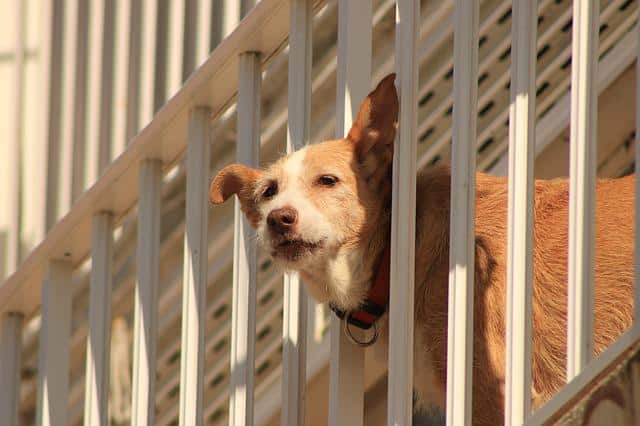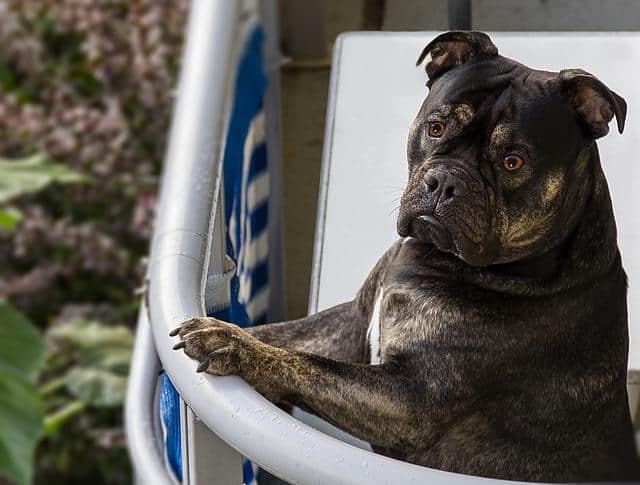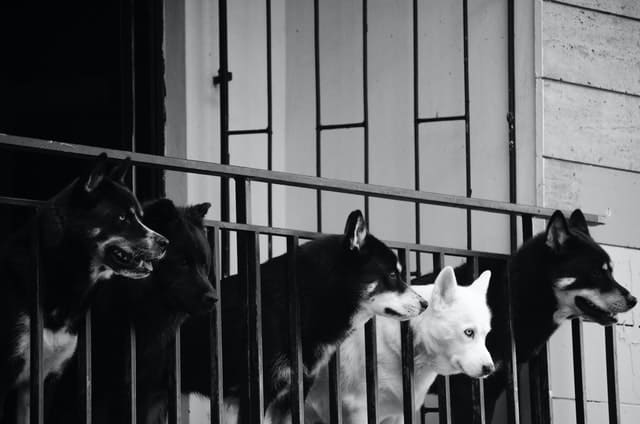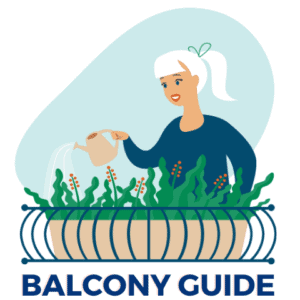
Do you want to be able to let your dog out on the balcony so it can enjoy the fresh air and scenery with you?
Well, in order to do this, you need to make sure your balcony and its railings are safe for dogs. In this article, we detail 5 simple steps on how to dog proof balcony railings.
Many balcony owners worry about their dogs jumping over the railing or squeezing through gaps. And rightly so, because if the railing is not tall enough or there are gaps, the dogs could fall and hurt themselves.
Another challenge is that balcony railings can sometimes have sharp edges around them which could cut or scrape the dog if they tried to climb on it or squeeze through it. Keep reading to learn how to make your balcony safe for your dog!
By the way, this article will focus on balcony railings since this seems to be the main concern for balcony owners with dogs, but we will also cover general tips on how to dog proof your balcony.
Additionally, if you’re also a cat owner, we recommend reading this article as well.
Now, let’s get started dog proofing!
1. Assess the height of your balcony railing
The first step to making your balcony railings safe for dogs is to assess the height of the railing. If it is not tall enough, your dog could potentially jump over it and seriously hurt itself.
Minimum height of balcony railing
The minimum height you should have for your balcony railing varies depending on where you are located geographically. If you’re unsure whether you are up to standards, contact your local authority or building association.
However, you know your dog best, so try also to consider if your railing is high enough already or if you believe it needs to be heightened.

Image from Pixabay
How to measure the height of your railing
You can measure the height of your railing with a tape measure. If it is not tall enough to protect your dog and align with local rules, you will need to take measures to make it taller.
Adding an additional layer of protection
One way to make your balcony railing taller is to add an additional layer of protection such as a lattice fence. Lattice fences are made of criss-crossing strips of wood or metal that often create a diamond pattern. They are often used as decorative features.
Another great (and beautiful) option to heighten the railing is to add a bamboo fence just inside the railing.
2. Make sure there are no gaps
Make sure there are no gaps in your balcony railing that your dog could squeeze through. The best way to estimate if the gaps are a threat to your dog is to measure the width and length of the gaps.
Usually, if a gap is wider than a foot, then your dog will most likely be able to squeeze through them, although it depends on what kind of dog you have. This is the most common type of gap that dogs can get through, so take extra precautions by preventing this from happening.

Image from Pexels
There might also be a gap between the balcony floor and the lowest point of the balcony railing/wall. If so, measure this gap and consider whether or not this gap needs to be enclosed as well.
How to close gaps in your balcony railing
If you have horizontal bars, consider adding vertical ones as well to close any gaps. Many materials can be used as a dog barrier or balcony gap blocker, from aluminum fencing to bamboo walls, etc.
Installing some form of robust netting or fine chicken wire usually also does the trick. Some dog owners also opt for installing plexiglass or glass panels as a dog barrier and to close gaps.
Here is a collection of balcony privacy screens where some could work for dog proofing as well.
3. Look for sharp edges on your balcony railing
There are different balcony railing systems, some with sharp edges on and around them. Therefore, inspect your balcony railing for any sharp edges that could injure your dog if it tried to climb on it or bite it, etc.
Gently sweep your hands over the balcony railing to see if there are any places where the railing is not smooth and uniform.
Even a small but sharp bump could be enough to cause injury or even death to your dog, so look for sharp corners and edges on your balcony carefully.
How to fix sharp edges on the balcony railing
The best way to fix any sharp edges on your balcony railing is to use a chisel to remove them or to sand the edges down.
You can use a file and sandpaper to smooth down any rough areas, but be careful not to sand beyond the point where the railing is no longer smooth!
If this doesn’t work, consider covering any rough areas with robust covering tape, padding, or similar.
4. Create a comfortable place for your dog
Another way to keep your dog on your balcony is to provide a safe and comfortable place for your dog to relax so that it is less likely to try and escape.
For example, this could be done by:
- Adding a dog potty, a freshwater bowl, and a dog bed.
- You could also give your dog a chew toy or bone that dogs love to keep it occupied for some time.
- Putting artificial grass as balcony flooring is usually a good way to create more of a cozy garden atmosphere in your balcony space.
- Adding railing planters with large and dense flowers can also help, given that the dog will have a harder time looking out at the surroundings and likely be less tempted to try to escape.
5. Train your dog to remain in place
Finally, when learning how to dog proof balcony railings, it is also a good idea to train your dog not to jump on or over the balcony railings. This could be done with positive reinforcements such as treats or praise. The method is similar to that of training your dog to go potty using a balcony dog toilet.
If your dog does try to jump on the railings, provide a negative consequence instead.
For example, if your dog jumps on the railings and you reach out to push it away and it pulls back, then you might firmly say “no” or “sit.” And don’t give in immediately. This will help your dog learn to have better control over its jumping.
Below is a great video on how one woman went about dog proofing her balcony:
Additional tips on how to dog proof your balcony
Use a leash if necessary
If your dog friend is a notoriously wild and jumpy one, always leash your dog with the assistance of a harness as opposed to a traditional collar when spending time on the balcony. This is to prevent your dog from hanging to death in case it jumps off the railing.
Plan furniture placements
When you furnish your balcony, pay attention to furniture placement. Make sure your furniture and tables are located far enough away from the railing so that your dog cannot use the furniture to jump from them over the railing. Try to use dog-friendly furniture if you need to have any furniture.
Use dog collar bumpers
Dog collar bumpers can help to keep the dog from getting his or her head caught between the railing gaps and potentially falling. This can help to prevent injury; however, it is not a bulletproof solution as the dog might still be able to jump over the rail and fall down.
Use non-poisonous plants only
When it comes to balcony gardening, there are a few things you should keep in mind to make sure your plants thrive and are safe for your dog.
For example, using only non-poisonous plants is a good rule of thumb to follow. Non-poisonous plants are less likely to cause any harm if ingested by children or dogs. So, before planting any flowers, do your research to find out which plants are safe for dogs and children!
Installing a dog barrier
To make the balcony as safe as possible, you may want to consider installing a barrier or fence around the railing to keep your dog from getting up on it in the first place.
We have already mentioned this action earlier in the article, but since it is so effective, we can’t stress this preventative method enough!
Entrance gate
If you believe none of the mentioned methods on how to dog proof balcony railings will be enough to protect your dog, you can also install a pet gate at the entrance to the balcony to keep your dog from getting out at all.
Final words on how to dog proof balcony railings
In conclusion, by following these simple tips above, you can keep your pooch safe while on the balcony. By ensuring that your railing is dog proof, you can help prevent any unnecessary accidents or injuries from happening. Keep all your pets safe this year in your outdoor space by taking the necessary precautions!
Want more useful balcony tips? Here’s our compilation of practical tips for maintaining balconies on houses and buildings.
Frequently asked questions
How do you doggy proof a balcony?
There are multiple ways to doggy proof a balcony, for example, you can install a “pet gate” at the entrance to the balcony. You could also install a fence or netting or an escape-proof window.
Do dogs know not to jump off balcony?
There is no definitive answer to this question as it depends on a number of factors, including the breed of dog and the height of the balcony. Some dogs may instinctively know not to jump off a balcony, while others may not be as cautious and could potentially injure themselves if they fall from a height.
Given the reasons above, it is best to dog proof your balcony and not take any chances when it comes to your dog’s safety.
Can I leave dog on balcony?
It depends on a variety of factors, including the specific breed of dog and the length of time it will be left alone. Generally speaking, however, it is not advisable to leave dogs alone on balconies, as they may become agitated or anxious and disturb the neighbors. It can also lead to a possible destruction of property or even injury to the animal.
Additionally, depending on the climate, leaving a dog outside on a balcony can be dangerous, as they may become overheated or succumb to cold weather conditions.
Finally, if the balcony is not screened in and dog-proofed, the dog may be able to jump off of it and get seriously injured. A better option would be to leave the dog in a kennel or another enclosed space where it will be safe and unable to disturb others.
Can puppies fall off balconies?
It depends on several factors, including the height of the balcony, the weight of the puppy, and the type of surface upon which the puppy lands.
That said, it is generally understood that puppies are small and lightweight animals, and so they may be more likely to suffer serious injury than an adult dog if they fall from a height.
This is because puppies are relatively light and have not yet fully developed their musculature, meaning that they are not as able to protect themselves from injury as adult dogs are.
How do you puppy proof high rise balcony?
There are a few things that you can do to puppy proof a high rise balcony. One is to make sure that there is no way for the puppy to get onto the railing. You can do this by putting up a fence or a gate. Another thing you can do is to make sure that there are no poisonous plants or objects on the balcony that the puppy could get to.
How do you puppy proof a railing?
It will depend on the specific railing in question and what kind of puppy you are dealing with. However, some general tips include making sure that the railing is too high for the puppy to jump up onto and making sure there are no gaps in or around the railing. Installing a cover or guard over the top of the railing to stop the puppy from getting his/her mouth around it can also be helpful.
Do dogs have a fear of heights?
There is some debate on whether or not dogs experience fear of heights. Some argue that dogs do experience fear of heights, but that it can manifest itself in different ways than it does in humans. Some dog breeds may be afraid of heights as low as a few feet off the ground, while others may not be afraid of heights at all. It is important to remember that dogs’ fear of heights can vary significantly from one individual dog to the next.
